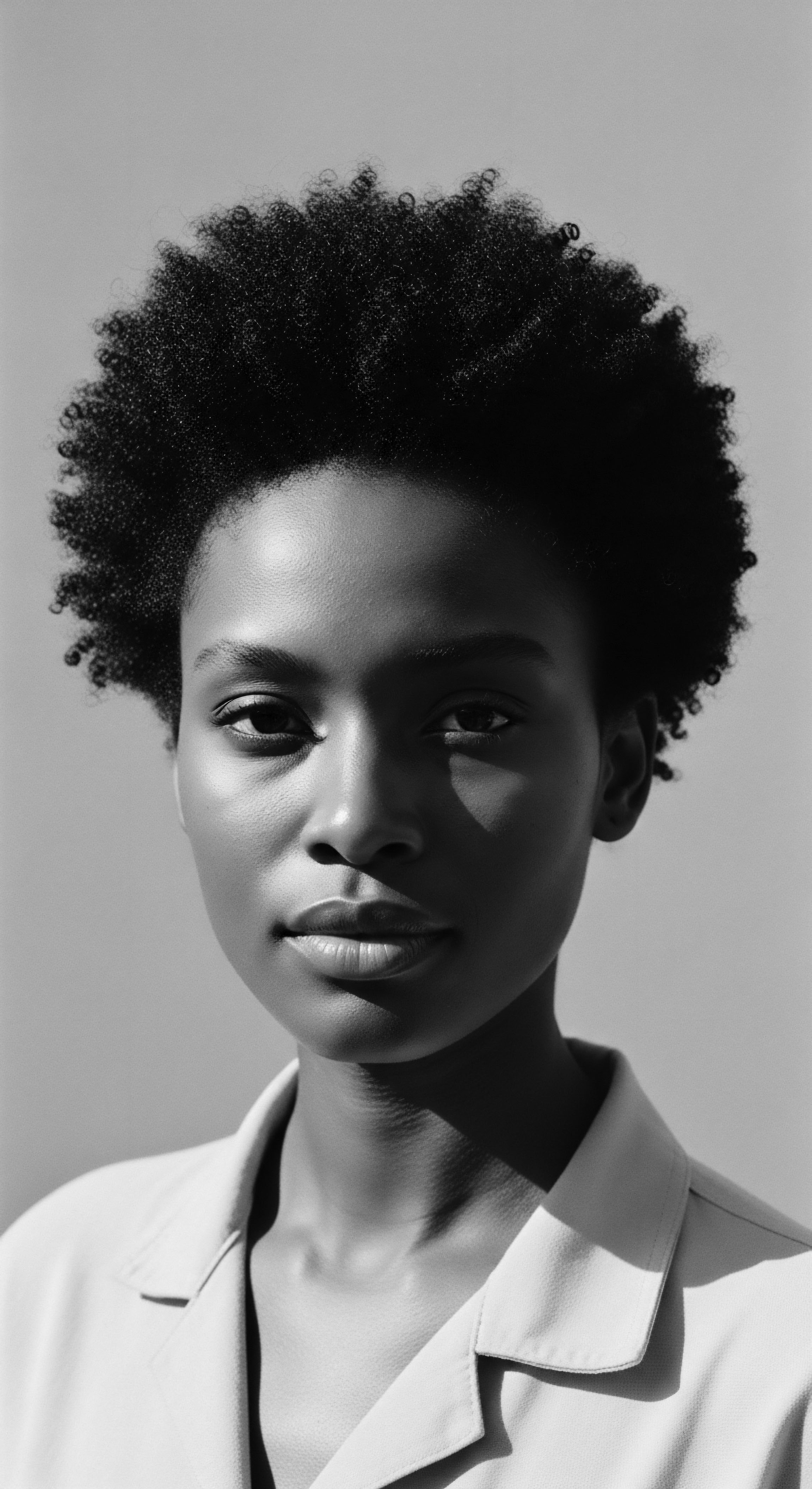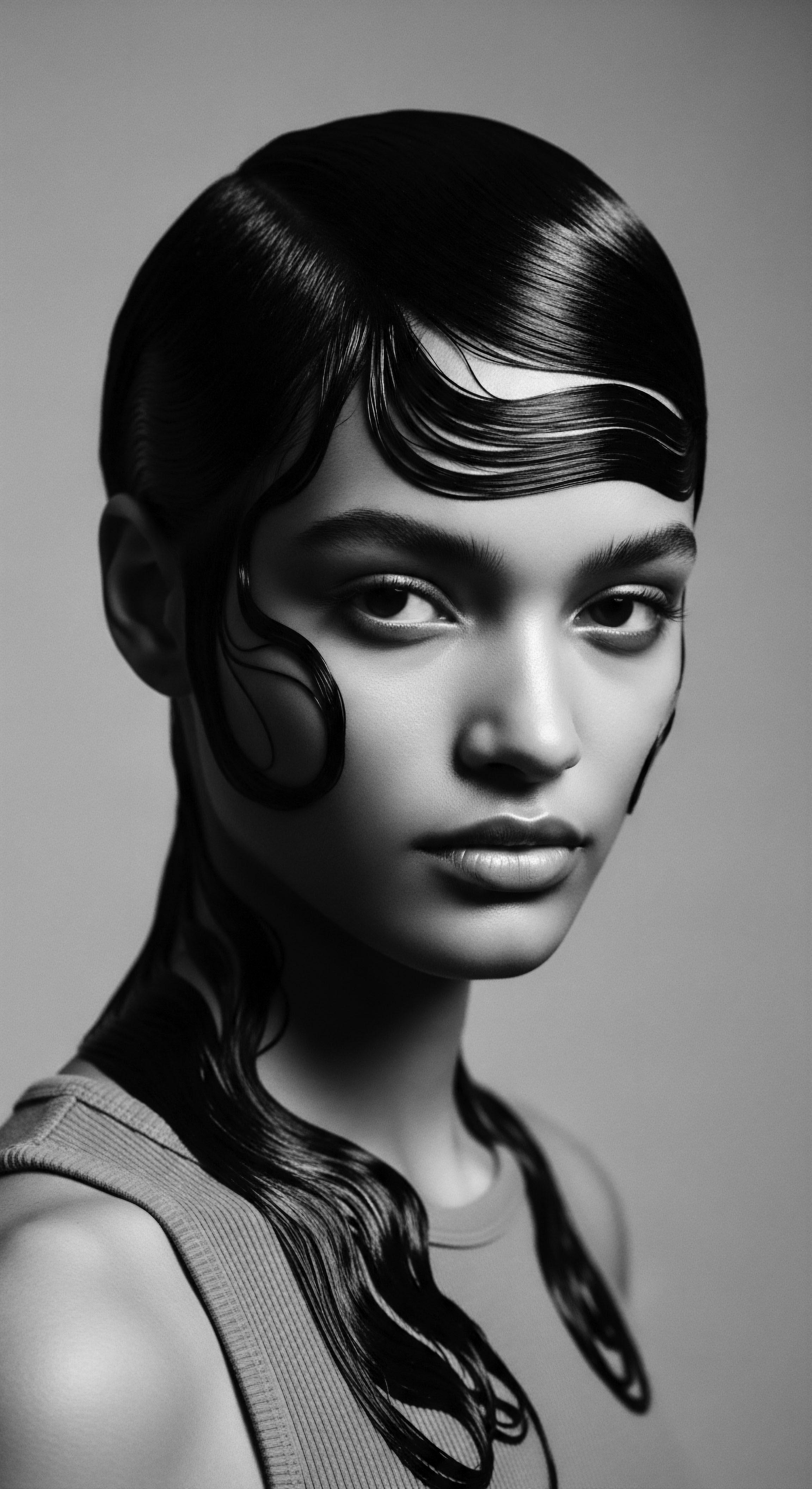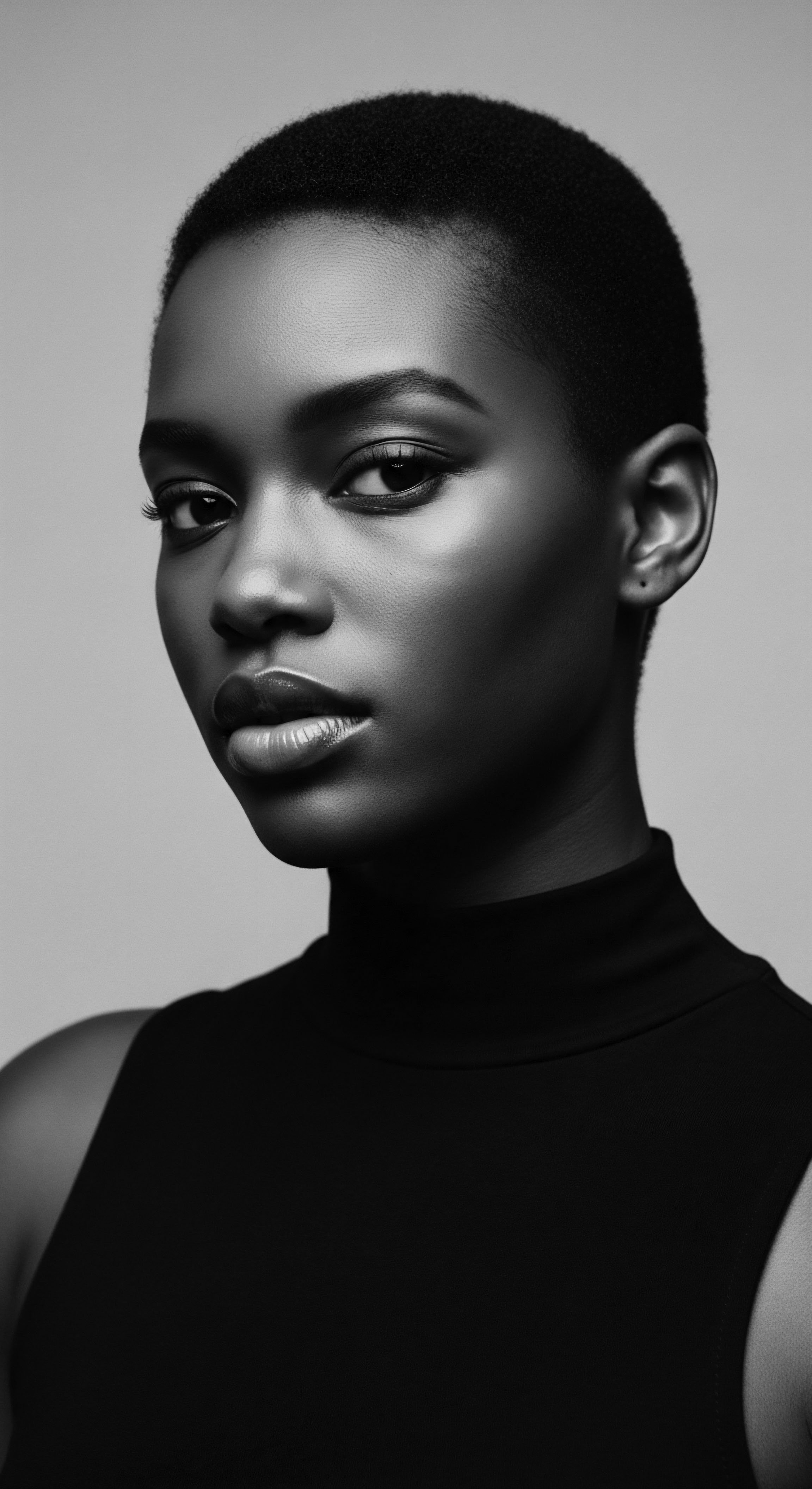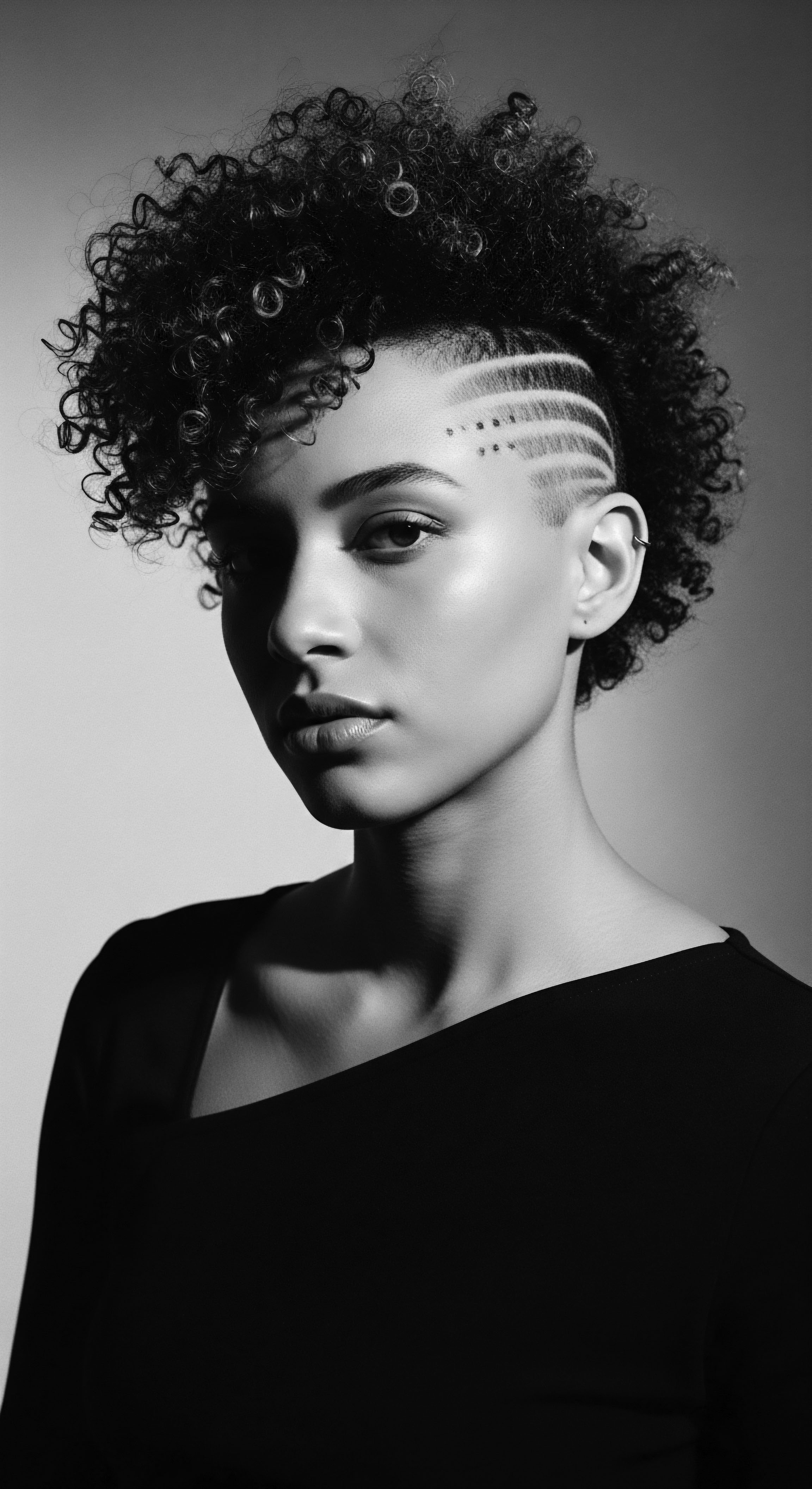
Roots
In the quiet contemplation of a single strand, one finds an immense narrative, a chronicle of lineage. Each curl, each coil, holds not only the memory of its biological unfolding but also echoes of profound ancestral wisdom, stories passed down through generations. To truly comprehend why textured hair is so deeply woven into identity, we must travel back, far beyond the confines of recent memory, to the wellsprings of human experience on the African continent. This is where the story of hair, heritage, and self truly begins for Black and mixed-race people, a profound connection etched into the very helix of being.

How does Textured Hair Connect to Ancient Beginnings?
The genesis of afro-textured hair reaches back to the very origins of humanity. Scientific inquiry suggests its distinctive spiraled structure, often described as coiled or kinky, evolved as a natural adaptation to the harsh equatorial sun. This unique form provided optimal protection for the scalp against intense ultraviolet radiation while simultaneously permitting air circulation for cooling, a testament to nature’s ingenious design (EBSCO Research Starters, 2023).
This biological marvel, a crown fashioned by the environment, became intrinsically linked to the earliest human communities, shaping their understanding of self and belonging. Hair was never merely an aesthetic detail; it was a living record of their very existence.
In pre-colonial African societies, the coiling strand held remarkable significance. It served as a sophisticated visual language, communicating a person’s life story, their place in the community, and their spiritual affiliations. One could read a person’s identity—their tribe, their marital status, their age, their wealth, even their familial lineage—by observing their hairstyle (Tharps & Byrd, 2001, p. 19).
Hair in ancient Africa was a social parchment, its styles broadcasting one’s deepest connections and standing.
The communal act of hair dressing solidified bonds, transforming a practical necessity into a cherished social ritual. These were moments of shared laughter, quiet counsel, and the passing of tradition from elder to youth, a tender thread connecting souls across generations (Afriklens, 2024). The head, as many African cultures held, was the most elevated part of the body, a conduit for spiritual energy and divine communication.
Thus, hair care became a sacred practice, a ritualistic engagement with the spiritual realm (African American Museum of Iowa, 2021). This understanding of hair as a spiritual anchor, a living legacy, underscores its foundational role in identity before the cataclysm of the transatlantic slave trade.

What Happened to Hair Heritage During Enslavement?
The arrival of the transatlantic slave trade brought an insidious assault upon this deeply ingrained heritage. Forced hair shaving upon capture and arrival in the Americas was a deliberate act of dehumanization, a symbolic stripping away of identity, culture, and dignity (Library of Congress, 2021). Enslaved Africans, severed from their traditional tools and practices, found themselves in brutal conditions that precluded the elaborate care their hair required. The very textures that once symbolized pride and ancestral connection were re-labeled as “unruly,” “nappy,” or “unprofessional” by enslavers, laying the groundwork for enduring societal biases against Black hair (Thrifts & Tangles, 2021).
Yet, even amidst such crushing oppression, the spirit of resilience burned. Hair, once a marker of identity, became a clandestine tool of resistance and survival. A poignant historical example illustrates this ❉ during the transatlantic slave trade, particularly in Brazil, enslaved African women, many of them rice farmers, braided rice seeds into their cornrows (BLAM UK CIC, 2022).
These hidden kernels served as a vital food source upon escape and a powerful symbol of hope, enabling survival and a connection to their stolen homeland (Substack, 2025). This ingenious act transforms hair from a mere biological outgrowth into a living archive, a silent testament to human ingenuity and the unwavering spirit of freedom.
| Pre-Colonial African Context Status Marker ❉ Hair styles denoted social rank, wealth, and age within communities. |
| During Enslavement and Beyond Identity Erasure ❉ Hair shaving was a dehumanizing act, removing traditional markers. |
| Pre-Colonial African Context Spiritual Connection ❉ The head and hair were seen as conduits to the divine. |
| During Enslavement and Beyond Tool of Resistance ❉ Hair used to hide seeds or create escape maps. |
| Pre-Colonial African Context Communal Ritual ❉ Hair care fostered social bonding and transmission of ancestral knowledge. |
| During Enslavement and Beyond Forced Conformity ❉ Pressure to straighten hair to meet Eurocentric beauty standards. |
| Pre-Colonial African Context The enduring significance of Black hair lies in its journey from a sacred cultural symbol to a powerful emblem of survival and resilience. |

Ritual
The rituals surrounding textured hair, from ancient communal gatherings to quiet, contemporary moments of self-care, tell a profound story of continuity and adaptation. These practices, honed over centuries, represent a living library of ancestral wisdom, transformed yet enduring through the crucible of history. Understanding the science that underpins their efficacy, particularly in the context of unique hair structure, only deepens our reverence for this inherited knowledge.

How Do Traditional Hair Care Practices Persist?
The very structure of afro-textured hair—its dense, spiral-shaped curls—possesses specific needs. It tends to be drier and more prone to breakage due to its curl pattern and fewer disulfide bonds (Curl Witch, 2024). This inherent characteristic made traditional African care practices, long before the advent of modern chemistry, remarkably prescient. Communities across the continent developed sophisticated methods and utilized indigenous ingredients to maintain hair health and integrity.
- Shea Butter ❉ Extracted from the nuts of the Shea tree, this rich butter has been a staple for centuries, prized for its moisturizing and protective properties. It seals moisture, guards against environmental stressors, and provides nourishment for both hair and scalp (Obscure Histories, 2024).
- Chebe Powder ❉ Originating from the Basara Arab women of Chad, this blend of natural herbs and seeds is applied to hair to coat, strengthen, and prevent breakage, contributing to length retention for coily hair types (Substack, 2025). This practice is deeply rooted in community and culture, passed down through generations (The History of Chebe Powder, 2025).
- Plant-Based Oils and Milks ❉ Coconut oil, aloe vera, and whipped animal milks were historically used across various African communities to nourish, condition, and enhance natural textures, maintaining moisture and promoting growth (Happi, 2021).
These practices were not isolated acts of vanity. They were collective endeavors, often performed by women for women, solidifying social bonds and fostering a sense of shared heritage (Afriklens, 2024). The rhythmic motion of braiding, the gentle application of oils, the shared space, all created an environment of care and connection that transcended mere grooming. This embodied knowledge, passed from mother to daughter, aunt to niece, became a powerful form of cultural memory.

What is the Sacred Space of Nighttime Hair Care?
The transition from day to night often brings specific rituals for textured hair, particularly for those whose ancestral heritage informs their daily practice. Nighttime hair care, often centered around protective styles and accessories like bonnets, speaks to a deep, practical wisdom born of centuries of experience. It addresses the inherent needs of curls and coils, which can easily tangle, dry out, or snag during sleep.
Nighttime hair rituals, often centered on bonnets, honor ancestral wisdom for curl preservation.
The bonnet, far from being a simple cap, represents a tangible link to historical practices of hair wrapping and protection. African villages utilized hair wraps in various prints and colors to signify tribe or social status, and they served the practical purpose of maintaining hair health and guarding against damage (Creative Support, 2022). This practical wisdom evolved.
Today, the silk or satin bonnet protects delicate strands from friction against absorbent pillowcases, preserving moisture, reducing tangles, and extending the life of styled hair. This simple, yet profound, act of nightly protection is a quiet testament to the enduring understanding of textured hair’s unique needs, a continuity of care from ancient traditions to contemporary life.
- Moisture Sealing ❉ Nighttime provides an opportunity to apply hydrating products, such as leave-in conditioners or oils, allowing them to deeply penetrate the hair shaft without immediate environmental exposure. This supports the natural moisture needs of textured hair.
- Friction Reduction ❉ The smooth surface of silk or satin bonnets minimizes mechanical stress on hair strands, preventing breakage and preserving curl definition.
- Style Preservation ❉ Protective wrapping helps maintain hairstyles, reducing the need for daily manipulation and heat, thereby contributing to overall hair health and length retention.

Relay
The narrative of textured hair, so deeply intertwined with identity, continues to unfold. It is a story of resistance, reclamation, and enduring cultural pride, passed forward through generations, each curl and coil bearing witness to a living heritage. The legacy of Black hair is not static; it is a dynamic force, shaping contemporary expressions of self and demanding recognition on a global stage, propelled by both historical memory and persistent advocacy.

How Did Hair Become a Symbol of Protest and Pride?
Following the era of enslavement and its persistent societal biases, Black hair became a powerful emblem of defiance. The mid-20th century, particularly the 1960s Civil Rights and Black Power movements, witnessed a profound shift. The Afro, with its voluminous, unapologetic silhouette, emerged as a symbol of Black pride, self-acceptance, and a direct challenge to Eurocentric beauty standards (Creative Support, 2022).
Iconic figures like Angela Davis, with her prominent Afro, transformed a hairstyle into a political statement, declaring autonomy over one’s body and heritage (Essence, 2020). This was a clear rejection of the damaging notion that natural Black hair was “unprofessional” or “undone” (Creative Support, 2022). The movement proclaimed that Black was beautiful, in all its forms, including hair texture, which was a revolutionary stance at the time (Thrifts & Tangles, 2021).
This historical moment laid the groundwork for the modern natural hair movement, which gained significant traction in the 2000s, amplified by digital platforms. Black beauty bloggers and content creators formed global communities, sharing care tips, celebrating natural textures, and challenging persistent discriminatory practices (The Well, 2022). This renewed celebration of coils, kinks, and waves connects individuals to a shared cultural memory, a lineage of resilience and beauty that spans continents and centuries (Afriklens, 2024).
| Historical Period Pre-Colonial Africa |
| Hair as Identity/Resistance A visual language denoting social status, marital status, age, wealth, and tribal affiliation. |
| Historical Period Enslavement Era |
| Hair as Identity/Resistance A tool for survival (e.g. hiding seeds for escape) and a symbol of cultural preservation despite forced shaving. |
| Historical Period Post-Emancipation to Mid-20th Century |
| Hair as Identity/Resistance Pressure to conform to Eurocentric standards, leading to widespread use of straightening methods. |
| Historical Period 1960s Civil Rights/Black Power Movement |
| Hair as Identity/Resistance The Afro becomes a powerful symbol of Black pride, liberation, and rejection of oppressive beauty norms. |
| Historical Period Contemporary Era |
| Hair as Identity/Resistance Natural hair movement flourishes, celebrating diverse textures, challenging discrimination through legal and social advocacy. |
| Historical Period From ancient signals to modern movements, Black hair has consistently embodied a powerful connection to heritage and selfhood. |

How does Hair Texture Continue to Shape Experiences Today?
Despite significant progress, the journey of Black hair remains complex. Discrimination based on hair texture persists in many professional and academic settings (Essence, 2024). This societal pressure to alter natural hair textures to conform to dominant beauty ideals can have profound psychological effects, impacting self-worth and mental wellbeing (Research, 2025). The enduring legacy of comparing Black hair to animalistic textures, a historical tactic to dehumanize, still reverberates in implicit biases (Thrifts & Tangles, 2021).
The ongoing societal perceptions of Black hair continue to affect personal identity and self-perception, a modern echo of historical biases.
Yet, the conversation surrounding Black hair has expanded, becoming a vibrant dialogue on identity, authenticity, and cultural preservation. Black and mixed-race individuals are increasingly reclaiming their heritage, asserting the right to wear their hair as it naturally grows. This continued affirmation of textured hair is not merely a styling choice; it is a declaration of self-love, a celebration of ancestral beauty, and a commitment to carrying forward a rich and complex cultural legacy.
The wisdom embedded in ancient care practices now finds new validation through scientific understanding, as research highlights the unique needs of textured hair and the efficacy of natural ingredients. This convergence of historical reverence and modern knowledge allows for a deeper appreciation of the strand’s profound connection to identity, a connection that is both deeply personal and universally resonant.

Reflection
The journey through the textured hair cosmos, from its very genetic blueprint shaped by ancient suns to its contemporary expressions of protest and joy, reveals an undeniable truth ❉ Black hair heritage is not a mere cultural artifact; it is a living, breathing component of identity. Each twist, every curl, each strand, whispers stories of survival, artistry, and an enduring spirit. This inherited crown, often challenged yet persistently reclaimed, is a testament to the resilience of a people, a tangible link to ancestral wisdom, and a powerful declaration of self in an ever-evolving world. It is the very soul of a strand, continuing its remarkable relay through time.

References
- African American Museum of Iowa. (2021). The History of Hair.
- Afriklens. (2024). African Hairstyles ❉ Cultural Significance and Legacy.
- Afriklens. (2024). How African Hairstyles Reflect Identity and Heritage.
- BLAM UK CIC. (2022). The History of Black Hair.
- Creative Support. (2022). The History of Black Hair.
- Curl Witch. (2024). The Science of Hair Texture ❉ Understanding Curl Patterns.
- EBSCO Research Starters. (2023). Afro-textured hair.
- Essence. (2020). BHM ❉ Black Hair and Political Statements.
- Essence. (2024). BHM ❉ Black Hair and Political Statements.
- Happi. (2021). Hair Care Is a Focus in Africa.
- Kodd Magazine. (2020). African hair tells a story and inspires the future.
- Library of Congress. (2021). Heavy is the Head ❉ Evolution of African Hair in America from the 17th c. to the 20th c.
- Obscure Histories. (2024). Ancient Gems ❉ A Historical Survey of African Beauty Techniques.
- Research. (2025). Beyond the roots ❉ exploring the link between black hair and mental health.
- Substack. (2025). Ancestral Hair Rituals to Nourish Your Hair and Soul.
- Tharps, L. & Byrd, A. (2001). Hair Story ❉ Untangling the Roots of Black Hair in America. St. Martin’s Publishing.
- The History of Chebe Powder ❉ An Ancient African Hair Secret for Hair Growth. (2025).
- The Well. (2022). What Everyone Needs to Know About Black Hair History.
- Thrifts & Tangles. (2021). The Evolution of Black Hair for Beauty & Resistance.
